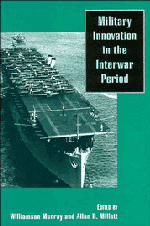Book contents
- Frontmatter
- Contents
- Acknowledgments
- Introduction
- 1 Armored warfare: The British, French, and German experiences
- 2 Assault from the sea: The development of amphibious warfare between the wars – the American, British, and Japanese experiences
- 3 Strategic bombing: The British, American, and German experiences
- 4 Close air support: The German, British, and American experiences, 1918–1941
- 5 Adopting the aircraft carrier: The British, American, and Japanese case studies
- 6 Innovation ignored: The submarine problem – Germany, Britain, and the United States, 1919–1939
- 7 From radio to radar: Interwar military adaptation to technological change in Germany, the United Kingdom, and the United States
- 8 Innovation: Past and future
- 9 Patterns of military innovation in the interwar period
- 10 Military innovation in peacetime
- Index
10 - Military innovation in peacetime
Published online by Cambridge University Press: 05 August 2012
- Frontmatter
- Contents
- Acknowledgments
- Introduction
- 1 Armored warfare: The British, French, and German experiences
- 2 Assault from the sea: The development of amphibious warfare between the wars – the American, British, and Japanese experiences
- 3 Strategic bombing: The British, American, and German experiences
- 4 Close air support: The German, British, and American experiences, 1918–1941
- 5 Adopting the aircraft carrier: The British, American, and Japanese case studies
- 6 Innovation ignored: The submarine problem – Germany, Britain, and the United States, 1919–1939
- 7 From radio to radar: Interwar military adaptation to technological change in Germany, the United Kingdom, and the United States
- 8 Innovation: Past and future
- 9 Patterns of military innovation in the interwar period
- 10 Military innovation in peacetime
- Index
Summary
And it is worth noting that nothing is harder to take in hand, more perilous to conduct, or more uncertain in its success, than to take the lead in the introduction of a new order of things.
Military organizations are societies built around and upon the prevailing weapons systems. Intuitively and quite correctly the military man feels that a change in weapon portends a change in the arrangements of his society.
The early Greek imagination envisaged the past and the present as in front of us – we can see them. The future, invisible, is behind us. … Paradoxical though it may sound to the modern ear, this image of our journey through time may be truer to reality than the medieval and modern feeling that we face the future as we make our way forward into it.
Looking back over the military history of the twentieth century, what were the fundamental technological, conceptual, operational, and organizational factors that, during times of peace, gave rise to fundamental changes in how military organizations would fight future wars? How long did it take individuals and organizations to move from a vague vision of a new or more effective way of fighting to mature capabilities they could exploit to underwrite success in actual combat? Did individuals or groups matter more in making progress toward such innovations – or is it even sensible to try to separate individual contributions from the organizational contexts in which they inevitably occurred?
- Type
- Chapter
- Information
- Military Innovation in the Interwar Period , pp. 369 - 416Publisher: Cambridge University PressPrint publication year: 1996
- 6
- Cited by



